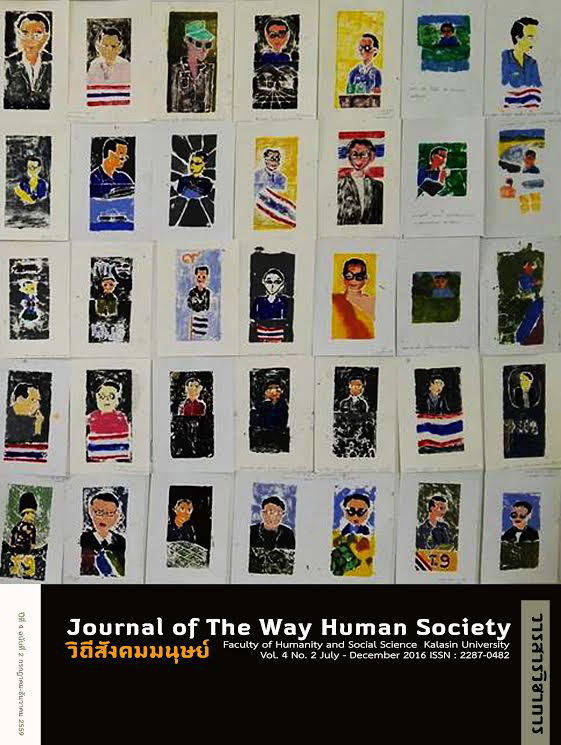การจัดการเรียนรู้รายวิชา 419317 สุนทรียศาสตร์ ตามกรอบมาตรฐานคุณวุฒิระดับอุดมศึกษาแห่งชาติ
คำสำคัญ:
การเรียนรู้, ผลการเรียนรู้, สุนทรียศาสตร์, กรอบมาตรฐานคุณวุฒิระดับอุดมศึกษา, Aesthetics, Learning, Outcome of Learning, Thai Qualifications, Framework for Higher Educationบทคัดย่อ
วิจัยเชิงคุณภาพนี้มีวัตถุประสงค์เพื่อศึกษาวิธีการเรียนรู้และผลการเรียนรู้ของนักศึกษาปริญญาตรีรายวิชา 419317 สุนทรียศาสตร์ตามกรอบมาตรฐานคุณวุฒิระดับอุดมศึกษาแห่งชาติ กลุ่มเป้าหมายได้แก่ นักศึกษาปริญญาตรีที่เรียนรายวิชา 419317 สุนทรียศาสตร์ ภาคการศึกษาที่ 1 ปีการศึกษา 2557 จำนวน 55 คน เครื่องมือที่ใช้ในการเก็บรวบรวมข้อมูล มี 3 ประเภทได้แก่ 1) บันทึกผลการเรียน 2) แบบประเมินการการเรียนรู้ตามกรอบมาตรฐานคุณวุฒิระดับอุดมศึกษาแห่งชาติ และ 3) แบบบันทึกการเรียนรู้สรุปภาพรวม วิเคราะห์เนื้อหาและนำเสนอข้อมูลโดยวิธีพรรณนาผลการวิจัยพบว่า
การเรียนรู้ ด้วยวิธีนิรนัย ตามหลักทฤษฎี CIPPA Model และ research-based learning ประกอบด้วยการฟังบรรยายเนื้อหา การทบทวนความรู้เดิม การแสวงหาความรู้ใหม่การศึกษาทำความเข้าใจข้อมูล / ความรู้ใหม่ และเชื่อมโยงความรู้ใหม่กับความรู้เดิมการแลกเปลี่ยนความรู้กับกลุ่ม การสรุปและจัดระเบียบความรู้ การทัศนศึกษาและ การแสดงนำเสอนหน้าชั้นเป็นขั้นตอนที่ช่วยให้ผู้เรียนนำความรู้ไปใช้ (Application) เนื้อหาสาระการเรียนประกอบด้วย ปรัชญาและาขา(สุนทรียศาสตร์) ความงามในปรัชญาตะวันตก-ตะวันออก เกณฑ์การตัดสินความงาม ประสบการณ์ทางสุนทรียะ ปัญหาทางสุนทรียศาสตร์
ผลของการเรียนรู้ รายวิชา 419317 สุนทรียศาสตร์ ตามกรอบมาตรฐานคุณวุฒิระดับอุดมศึกษา ทั้ง 5 ด้าน คือ ก. เรื่องของคุณธรรมจริยธรรมที่ปรากฏคือ ไม่คัดลอกงานของเพื่อนมาส่ง ข. ความรู้ ที่ได้คือด้านปรัชญา เนื้อหาสุนทรียศาสตร์และศิลปะต่างๆ เกณฑ์การตัดสินความงาม ประสบการณ์สุนทรียะ เทคนิคการถ่ายภาพ ปัญหาสุนทรียะ ค.ทักษะทางปัญญา คือการใช้แนวคิดทางปรัชญาและสุนทรียศาสตร์ในการวิเคราะห์ผลงานศิลปะประเภทต่าง ๆ ง.ทักษะความสัมพันธ์ระหว่างบุคคลและความรับผิดชอบ ระหว่างบุคคลนั้นเกิดจากการทำกิจกรรมกลุ่ม 5 กิจกรรมทำให้นักศึกษาได้พูดคุยปรึกษากันมากขึ้น มีส่วนในการรับผิดชอบในงานของกลุ่ม มีการช่วยเหลือกันและกัน เห็นอกเห็นใจกัน ได้รับฟังความคิดเห็นของเพื่อน ได้รู้จักเพื่อนพี่ๆต่างคณะต่างสาขา มีความกล้าแสดงออก จ. ทักษะการวิเคราะห์เชิงตัวเลข การสื่อสาร และการใช้เทคโนโลยีสารสนเทศ คือทักษะการสื่อสารผ่านสื่ออิเลกทรอนิกส์ เช่น e-Mail, e-Learning, face book, Google, และการจดบันทึกและฟังบรรยาย เพราะในชั้นเรียน การได้แลกเปลี่ยนความคิดเห็นจากเพื่อนต่างคณะที่มีความสามารถหลากหลาย นักศึกษาสามารถนำมาปรับปรุงตัวเองและพัฒนาต่อได้
The objectives of this qualitative research were to study the method of learning t and out come of learning according to Thai Qualification Frameworks for Higher Education. The study was undertaken 55 Aesthetics students who enrolled in the first Semester of the academic years 2014. All data were collected in three ways viz. 1) learning note of Aesthetics, 2) filed work note and 3) Post – Lesson Report of Aesthetics Course. The data were also collected from the tests and activities. The results were presented by the descriptive analysis. The results were as follows:
According to the method of learning and its outcome of the Aesthetics course based on the Thai Qualifications Framework for Higher Education, this course was conducted by the deductive method based on the CIPPA Model and the Research – Based Learning Theory. The theories were involved with the lecturing content, reviewing the previous knowledge, reaching for the new content, learning and understanding of the new contents and linking the old knowledge with the new knowledge, sharing knowledge with fellow students, summarization and knowledge management and practicing and / or exhibitions. The last step, the students can apply their knowledge effectively.
Regarding to the results of the above-mentioned Aesthetics learning process, it was found in five aspects as A) on the ethical aspect, the teacher taught students to realize and to discuss on ethical issues, i.e., cohabiting before marriage. B) On philosophical issues, the teacher taught the essence of aesthetics and arts such as the criteria of beauty, aesthetic experience, imaging techniques and the problems of aesthetics. C) On the intellectual skill – the teacher taught the application of philosophical and aesthetic ideas to critique the works of art. D) On the interpersonal and responsibility – Using the grouped activity. The grouped activity was divided into five groups, therefore, the students have the opportunities to share and learn from each other in various aspects viz. responsibility, sympathy and friendliness from students of different faculties. Last, E) On the Numerical, Communication and Technologies analysis skill - Taking communication skills via e-Mail, e-Learning, facebook, and google. Taking a note, listening a lecture and exchanging ideas of each other can be undoubtedly developed themselves.


